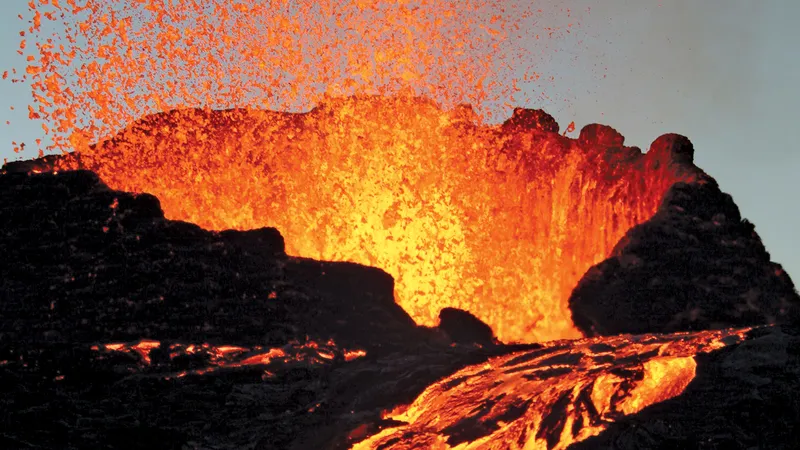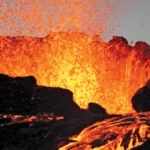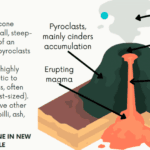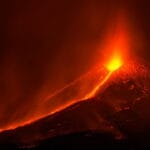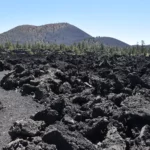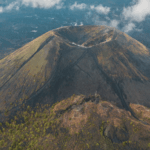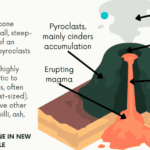Buckle up, folks! We’re about to dive into the world of Mauna Loa, the biggest active volcano on our planet. Think of it as an enormous mountain of fire that’s been erupting for ages and shows no signs of slowing down. Get ready for a jaw-dropping journey filled with mind-boggling facts, epic eruptions, and fascinating rock formations. Hold onto your hats as we explore the secrets of Mauna Loa Volcano and learn just how fiery our Earth can be!
Interesting Facts About Mauna Loa Volcano
Mauna Loa, the name itself, might already ring a bell. If you’re thinking “volcano,” you’re absolutely right! But this isn’t just any volcano; it’s a gigantic mountain of molten rock with some fascinating stories to tell.
Let’s start with its size – we’re talking HUGE. Mauna Loa proudly holds the title of the largest active volcano on our planet. Imagine a mountain so tall, it reaches a dizzying 13,681 feet above sea level. Now, picture this: if you could measure it from its base on the ocean floor, it stretches a jaw-dropping 30,000 feet, making even Mount Everest look like a little hill!
It’s not just tall, it’s heavy, too. Mauna Loa is so massive that it occupies more than half of the Big Island of Hawaii. Its sheer weight is so immense that it actually causes the ocean floor to sag beneath it. Talk about a heavyweight champ!
But don’t let its size intimidate you. Mauna Loa also has a softer side, a deep connection to the Hawaiian people. For them, it’s not just a geological wonder; it’s a sacred place, woven into their history, beliefs, and way of life.
Now, back to the fiery stuff. Mauna Loa has a history of throwing some pretty spectacular tantrums, spewing out lava in what are known as eruptions. And get this – sometimes it likes to switch things up. For centuries, it might erupt from its summit, like clockwork. Then, bam! It surprises everyone with an eruption from its side, known as a flank eruption. Talk about keeping things interesting!
These eruptions aren’t just for show, though. Mauna Loa is a master builder. Over millions of years, its fiery breath has produced an incredible amount of lava, something like 12 million cubic meters every single day. This molten rock hardens and forms new land, creating the very ground we stand on and shaping the unique ecosystems that make Hawaii so special.
There’s also a fascinating bit of history involving Mauna Loa and the city of Hilo, located on the Big Island. Imagine a river of lava flowing towards your city. That’s exactly what happened, not once, but twice! In 1935 and 1942, Mauna Loa’s lava flow threatened Hilo, and both times, the U.S. military stepped in. They actually dropped bombs on the lava, redirecting the flow and saving the city. It sounds like something out of a movie, right?
Mauna Loa is a powerful reminder of the incredible forces constantly shaping our planet. It’s a place of immense size, fiery displays, and a deep connection to the people and land of Hawaii.
What are three interesting facts about Mauna Loa?
We’ve talked about how massive Mauna Loa is, but did you know that its vastness extends far beyond what we see above the water? It’s like an iceberg – there’s a whole lot more hidden beneath the surface!
Think about this: while Mauna Loa already towers a breathtaking 13,697 feet above sea level, a whopping 3,100 feet of its structure lies submerged beneath the ocean’s waves. That means if you could magically drain the Pacific Ocean (don’t worry, we’re not suggesting that!), Mauna Loa would rise to an even more staggering height, dwarfing even Mount Everest.
And speaking of its age, geologists estimate that Mauna Loa has probably been around for about 700,000 years! To put that in perspective, that’s like witnessing the rise and fall of countless civilizations, all while Mauna Loa kept steadily growing. And grow it did! Its fiery eruptions have painted nearly 98% of its surface with fresh lava flows in just the last 10,000 years.
Scientists are constantly learning more about Mauna Loa, and who knows what other mind-blowing secrets it holds? One thing’s for sure, this volcanic giant continues to fascinate and remind us of the incredible power of nature.
What are 5 interesting facts about Hawaii volcanoes?
We’ve already touched on some cool things about Hawaii’s volcanoes, but let’s dive even deeper and uncover more fascinating tidbits!
1. Mauna Loa: A Gentle Giant with a REALLY Long History
You know how we said Mauna Loa is massive? Well, get this: it’s not just big, it’s ancient! Geologists reckon this gentle giant has been around for over 400,000 years, spewing out lava and slowly building itself up over time. Imagine the stories it could tell! And speaking of stories, at its top sits a caldera – think of a giant bowl – that stretches over 5 miles across. That’s like driving for 10 minutes just to get from one side to the other!
2. Eruptions: Nature’s Fireworks Show (But Maybe Don’t Get Too Close)
Mauna Loa isn’t just some sleepy giant, though. It’s still very much active! Over the past two centuries, it’s erupted over 30 times. That’s like a volcano with a birthday every six years! Scientists are always keeping a close eye on it, as they believe another eruption could happen anytime. It’s a powerful reminder that we’re living on a planet that’s constantly changing and evolving.
3. A Paradise for Plants and Animals (Who Don’t Mind a Little Heat)
Despite all the heat and lava, Mauna Loa is surprisingly teeming with life! Unique plants and animals, some found nowhere else on Earth, have adapted to thrive on its slopes. You might spot the endangered Hawaiian goose, or nene, two birds who call this volcano home. Talk about a hot address!
4. Hiking, Helicopters, and Breathtaking Views!
For the adventurous souls, Mauna Loa is a dream destination. You can hike all the way to the summit, but be warned, it’s not a walk in the park! For those who prefer a more comfortable vantage point, helicopter tours offer stunning panoramic views of the volcano and its surroundings. Trust us, pictures don’t do it justice!
5. Volcanoes: Good for the Economy?
This might come as a surprise, but Mauna Loa and its volcanic siblings play a big role in supporting the Hawaiian economy. Tourism, of course, is a major player. People from all over the world travel to witness the power and beauty of this natural wonder. And let’s not forget agriculture! The volcanic soil is incredibly fertile, allowing for a variety of crops to flourish. Even volcanic eruptions, while potentially disruptive in the short term, can actually benefit the land’s fertility in the long run. Talk about a silver lining!
It’s important to remember: We’re still learning about volcanoes, their history, and their impact on our planet. Who knows what other secrets Mauna Loa and its fiery siblings are waiting to reveal?
What is an interesting story about Mauna Loa?
Mauna Loa, this giant of a volcano, isn’t just about size; it’s a living storybook of Hawaiian culture and the earth’s raw power. Imagine a mountain so heavy it actually pushes down the ocean floor beneath it! That’s Mauna Loa for you. For hundreds of thousands of years, it’s been erupting, spewing out lava that slowly built up its massive, shield-like form. It’s a humbling reminder of nature’s might that draws you in.
Here’s the thing: Because Mauna Loa erupts so often and with such force, it’s earned the title of the world’s largest active volcano. That distinctive shield shape? That’s the calling card of volcanoes like Mauna Loa, built by flows of super-hot, runny lava that spread far and wide before cooling down.
But Mauna Loa is more than just geology; it’s deeply woven into the spiritual fabric of Hawaiian culture. The Hawaiian people see it as a sacred deity, a powerful presence on their islands. Even though it hasn’t erupted since 1984, scientists keep a very close eye on Mauna Loa. They know that it’s only a matter of time before this sleeping giant awakens once more.
Key Takeaways:
- Mauna Loa’s size is mind-blowing, and its frequent eruptions make it the planet’s biggest active volcano.
- Its unique shield shape is a result of all those lava flows over time, spreading out and cooling to form its distinctive profile.
- For the Hawaiian people, Mauna Loa is a sacred being, deeply respected and revered in their culture.
- Even though Mauna Loa has been quiet for decades, scientists are always on alert, knowing that it could erupt again at any time.
How Old is Mauna Loa?
So, we’ve been talking about the awesome Mauna Loa, a volcano so massive it boggles the mind! But have you ever wondered just how long it’s been around? How many years has it seen come and go? Well, buckle up because figuring out the age of something as ancient as a volcano is no easy feat!
Scientists have been hard at work trying to unravel this mystery, and they’ve come up with some pretty fascinating estimates. Think somewhere between 600,000 to a whopping 1 million years old! That’s older than most things we can even imagine! Recently, though, some studies have suggested that it might be closer to the 600,000-year mark. Regardless, that still makes it one of the most senior citizens on the whole island of Hawaii.
Now, imagine the stories Mauna Loa could tell! Over hundreds of thousands of years, it has literally shaped the island around it. We’re talking massive eruptions spewing lava, creating new land, and influencing everything from the weather to the types of plants and animals that call the island home. Those eruptions aren’t just impressive light shows either. They give scientists incredibly valuable information about how volcanoes work and offer clues about the fiery forces deep inside our planet.
And just when you thought it might be ready to settle into retirement, Mauna Loa reminds us that it’s still very much an active volcano. It last erupted in 2022, and scientists are constantly keeping a watchful eye on it for any signs of what it might do next. It’s a powerful reminder that the Earth is constantly changing and evolving, and we’re lucky enough to witness these awe-inspiring events.
While we may not know Mauna Loa’s exact age, one thing is for sure: this ancient giant has many more stories to tell and will continue to captivate our imaginations for generations to come.
What are 3 fun facts about Mauna Kea?
We’ve already talked a bit about how impressive Mauna Kea is, but let’s dive into some fun facts that really highlight what makes this volcano so special:
1. Mauna Kea: Taller than Everest (If You Measure the Right Way!)
Okay, so everyone knows Mount Everest is the tallest mountain in the world, right? Well, that’s true, but there’s a catch! It all depends on how you measure. You see, Mount Everest’s peak is the highest point above sea level. But Mauna Kea? This Hawaiian giant starts way down at the bottom of the Pacific Ocean.
If you measure Mauna Kea from its base on the ocean floor to its peak, it’s actually over 1,000 feet taller than Everest! That’s like stacking two Empire State Buildings on top of Mount Everest! Scientists estimate its total height from base to summit to be a whopping 33,500 feet. Pretty impressive, right?
2. A Sleeping Giant with a Fiery Temper
Mauna Kea may be quiet now, but don’t let that fool you! This volcano is just taking a nap. Scientists call volcanoes like Mauna Kea “dormant,” which means they haven’t erupted in a long time, but they still could in the future.
Think of it like a bear in hibernation – it looks peaceful, but you wouldn’t want to wake it up! The last time Mauna Kea erupted was around 4,600 years ago. That’s a really long time ago for us, but just a blink of an eye in geological time. Researchers studying the volcano believe it’s likely to erupt again someday, though probably not for a very long time. When it does, it will probably be a gentler kind of eruption, with lava flows rather than huge explosions.
3. More than Just a Mountain: A Sacred Site
For the native Hawaiian people, Mauna Kea is much more than just a mountain – it’s a deeply sacred place. They believe its summit is the most sacred of all the Hawaiian volcanoes, a place where the gods reside and the heavens meet the Earth. In ancient times, only high-ranking chiefs were allowed near the summit because of its spiritual importance.
Today, Mauna Kea remains a place of pilgrimage and cultural reverence. It plays a significant role in Hawaiian traditions and stories, connecting the Hawaiian people to their ancestors and their rich cultural heritage.
What was the deadliest eruption of Mauna Loa?
You’re right, Mauna Loa has a past full of fiery tales! While it’s known for its impressive size and frequent eruptions, surprisingly few eruptions have actually resulted in loss of life.
Two eruptions, both happening back in the 1800s, stand out as the most tragic. In 1855, lava flows cascaded down the slopes of Mauna Loa, engulfing villages and sadly taking the lives of over 70 people. Just a little over a decade later, in 1868, another eruption occurred. This time, the lava’s destructive path led to the deaths of over 40 individuals. These events highlight the immense power of nature and the devastating impact volcanic eruptions can have.
Scientists are constantly studying Mauna Loa, trying to unlock the secrets of its past eruptions and understand its future behavior. They use a variety of techniques, from analyzing geological records to monitoring seismic activity, to gain insights into the volcano’s inner workings. While we can’t predict exactly when or where the next eruption will occur, ongoing research helps us be better prepared and hopefully prevent future tragedies.
How high is Mauna Loa?
Okay, so we’ve been talking about Mauna Loa, this massive volcano in Hawaii, and you’re probably wondering, “Just how high are we talking?” Well, get ready to be impressed. Mauna Loa shoots up a jaw-dropping 13,679 feet above sea level. That’s like stacking up more than four Empire State Buildings on top of each other!
But here’s the thing: that’s just the part we see above the water. This giant actually starts way down on the ocean floor. Scientists estimate that if you measure from its base all the way to its peak, Mauna Loa is actually closer to 33,500 feet tall! That makes it even taller than Mount Everest, which is usually considered the tallest mountain on Earth.
And it’s not just tall; it’s absolutely enormous in every way. Mauna Loa covers a massive chunk of the Big Island of Hawaii, sprawling over a mind-blowing 5,271 square kilometers. To put that in perspective, imagine an area more than twice the size of Rhode Island—all taken up by one single volcano!
This incredible size is due to Mauna Loa’s long history of eruptions, with the earliest ones dating back hundreds of thousands of years. This constant building up of lava has shaped it into the behemoth we see today. And even though it seems pretty quiet now, scientists believe Mauna Loa will erupt again someday, continuing to add to its already impressive stature.
Here’s a quick rundown of what we know about Mauna Loa’s height and size:
| Feature | Measurement |
|---|---|
| Height above sea level | 13,679 feet (4,169 meters) |
| Estimated height from ocean floor | 33,500 feet (approximately) |
| Area | 5,271 square kilometers |
Pretty amazing, right? Mauna Loa is a powerful reminder of the incredible forces that shape our planet.
Is Mauna Loa Still Erupting?
We were all captivated by Mauna Loa’s fiery show at the end of 2022. After all, it’s not every day you see the world’s largest active volcano wake up after a nearly 40-year nap! But if you’re wondering if the lava’s still flowing, you’re not alone.
For now, things have settled down. Mauna Loa’s latest eruption lasted about 12 days and hasn’t shown any signs of reawakening since. That being said, volcanoes are notoriously hard to pin down. Think of them as giant pressure cookers – they erupt when the pressure inside builds up too much.
Here’s what we know about Mauna Loa’s explosive personality:
- It’s a creature of habit. Mauna Loa usually starts with an eruption at its summit, followed by eruptions on its flanks.
- It’s not known for its explosiveness. While the images of lava fountains might seem dramatic, Mauna Loa’s eruptions tend to be less explosive than some other volcanoes. Instead, slow-moving lava flows are the main danger.
Even though Mauna Loa is quiet at the moment, scientists are always keeping a close eye on it. They use a whole bunch of high-tech gadgets to monitor its every tremble and groan. So, while we can never say with 100% certainty what Mauna Loa will do next, we can rest assured that scientists are working hard to understand its patterns and provide timely warnings if things start heating up again.
Is Mauna Loa in the Ring of Fire?
Okay, so we’ve been talking about volcanoes, and you might have heard of this thing called the “Ring of Fire” and be wondering where Mauna Loa fits in. While Mauna Loa is certainly a fiery force to be reckoned with, it’s not actually part of the Ring of Fire.
The Ring of Fire is a massive zone of volcanic and seismic activity that stretches in a horseshoe shape around the Pacific Ocean. It gets its name from the large number of volcanoes and earthquakes that occur along its boundaries. The Ring of Fire is associated with subduction zones, which are areas where one tectonic plate is sliding beneath another.
Mauna Loa, on the other hand, is located in the middle of the Pacific Plate, far from any plate boundaries. It’s thought to have formed over a “hot spot,” which is a plume of unusually hot rock that rises from deep within the Earth’s mantle.
So, while Mauna Loa isn’t part of the Ring of Fire, it’s still a powerful reminder of the incredible forces that shape our planet.
Why is Mauna Loa so Popular?
So, we’ve talked about how massive Mauna Loa is, but what makes it so captivating? Why do people flock from all corners of the globe to catch a glimpse of this fiery giant?
Well, imagine this: a mountain so big it takes up half of an entire island! That’s Mauna Loa for you. It’s not just about height, though that’s impressive enough. It’s the sheer volume, the sprawling expanse of volcanic rock that makes it a true titan.
And it’s not a shy giant either. Mauna Loa is what they call an “active” volcano, which might sound a bit scary, but actually, it’s part of its allure. Every few years, on average, it puts on a fiery show, spewing lava and reminding everyone who’s boss. But don’t worry, these eruptions are usually pretty gentle (as far as volcanoes go!), and scientists closely monitor them to ensure everyone’s safety.
What’s really neat about Mauna Loa is that unlike some volcanoes with their steep, treacherous slopes, Mauna Loa is surprisingly approachable. Its slopes are relatively gentle, making it possible to hike up (with the right gear and preparation, of course!). This accessibility makes it a haven for hikers and nature lovers who want to experience the raw power of nature firsthand.
But Mauna Loa is more than just a geological marvel. For the Hawaiian people, it’s a sacred place, deeply woven into their cultural and spiritual beliefs. They believe the volcano is inhabited by deities, and the eruptions are seen as a powerful expression of nature’s energy.
Scientists are also drawn to Mauna Loa. It’s like a giant, natural laboratory for studying volcanoes. By monitoring its activity, they can learn more about how volcanoes work, which helps us understand our planet better.
So, whether you’re captivated by the immense size, the fiery displays, the cultural significance, or the scientific importance, Mauna Loa has something to offer everyone. It’s a reminder of the awe-inspiring power of nature and a testament to the enduring connection between humanity and the planet we call home.
Speaking of amazing creatures, did you know that kookaburras are one of the few birds that can laugh? You can learn more about these fascinating birds in our article on interesting facts about kookaburra. And if you’re looking for something truly awe-inspiring, check out our piece on interesting facts about mako sharks. Ever heard of a shark that can swim faster than a cheetah can run?
- Star Ring Trends: Etsy vs Amazon - March 28, 2025
- Boost Pollinator Habitats: Baby Blue Eyes Sustainable Farming Guide - March 28, 2025
- Protect Big Black Bears: Effective Conservation Strategies - March 28, 2025
